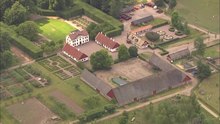Fredriksdal Open Air Museum
The Fredriksdal Open Air Museum ( Swedish Fredriksdal museer och trädgårdar ) is an open air museum in the Fredriksdal district of the Swedish city of Helsingborg in the province of Skåne län .
history
In 1918 Gisela Trapp, the widow of Helsingborg historian Oscar Trapps, donated the Fredriksdal estate with the associated lands to the city museum on the condition that an open-air museum be set up there and that the land be used to finance the museum's operations.
The open-air museum, which opened in 1926, is one of the largest open-air museums in Sweden with over 36 hectares. It consists of a manor house from the 18th century, historical buildings transferred to the museum from some provinces in southern Sweden, an open-air theater, rows of houses from the center of Helsingborg and a historically managed farm with fields, meadows, fields and pets. It is embedded in the historic park of the manor house, which also includes a botanical garden .
The museum's logo consists of a stylized tree in white on an olive green background and was designed by Bodil Tegsell. The logo won the Swedish Design Award in 2006 in the "Identity Print - Profile" category.
The mansion
The mansion Fredriksdals Villa , located in the center of the entire system today is a white building Gustavian style today. The first building was built in 1787 by Fredrik Wilhelm Cöster Sr. as a summer residence for the Cöster family. Fredriksdalsteatern is not a mansion in the strict sense as it was built for a middle-class family. The building was rebuilt and expanded several times during the 19th century. In 1898 the engineer and politician Oscar Trapp bought the Fredriksdal estate, on which he lived until his death. After his death in 1916, his second wife Gisela Henckel donated the house and park to the city of Helsingborg.
The park and the botanical garden
The park was originally laid out together with the manor house. Its oldest parts still preserved today at the main entrance and the herb garden on the north side of the manor house are designed in the French garden style. In the south of the park there is an English landscape garden . To the south of the manor house is a vegetable garden which, including pest control, is cultivated as it was 150 years ago. The oldest trees in the orchard with over 130 varieties were planted in 1845. In the park there is a café and a botanical garden . This was built in the 1930s and financed by a donation from Gisela Trapp. Over 40 different plants from the Skåne province are cultivated in different habitats and in a forest. It is the only botanical garden in Sweden that specifically houses the plants of a province.
The museum
The oldest farm in the museum is Lillarydsgården. It comes from the municipality of Perstorp in the north of the province of Skåne in the early 17th century. The farm Ågård, built in the 19th century, comes from southern Småland , Harlyckesmedjan from Helsingborg and the Ringstorps mill, built in 1803, was originally in the Ringstorp district in Helsingborg. Two mills date from the 18th century, one sawmill from the 19th century. There is also a water mill in the form of a horizontal mill , a barn from southern Halland and several smaller buildings.
The streets of Helsingborg's old town have been transferred to another part of the museum. They were moved to the museum in the 1940s to 1960s when parts of the old town were demolished for reasons of modernization. In some buildings the interiors and workshops have been preserved. Other buildings house a theater museum, a museum of local history and the largest graphic museum in Sweden. It shows the history of printing from Gutenberg to the present day.
Events
The museum events include around 50 different offers for children, but also for people of all ages, especially at Easter, on the national holiday, midsummer and Christmas. Other events include a rose day for rose growers, a Michaelmas market, and a harvest festival. There are also historical walks for children and various garden shows.
See also
Web links
Coordinates: 56 ° 3 ′ 21 ″ N , 12 ° 42 ′ 34 ″ E





